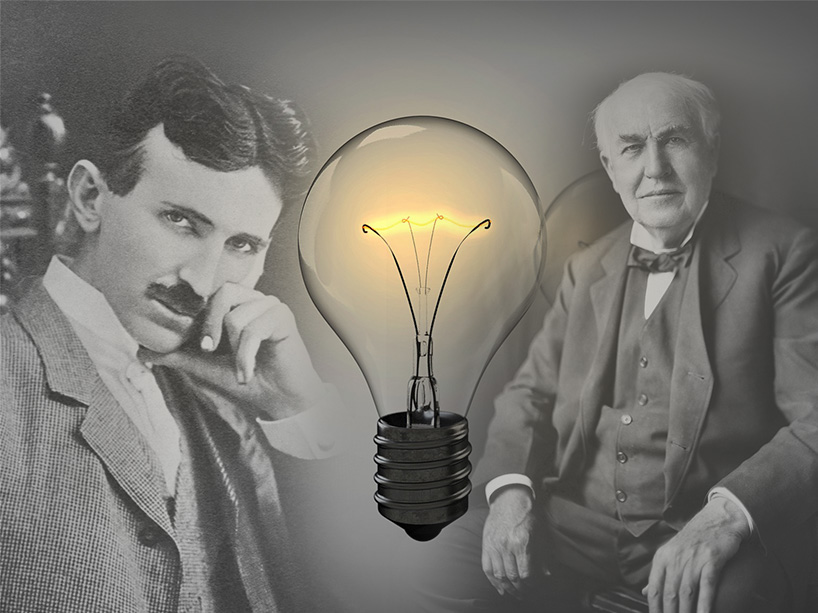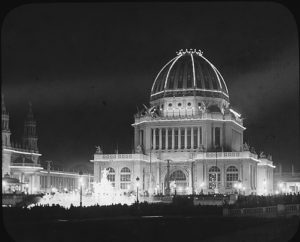
One of the most famous face-offs in history is the battle of wills and minds between Nikola Tesla and Thomas Edison. In fact, both men faced great challenges in their quest to harness electric power. Their goal was to make electricity useful for mankind. My great-grandfather, John Kruesi, was Edison’s “right-hand man.” So you might fear that I will stack the deck in Edison’s favor. Not so—both Tesla and Edison deserve recognition as two of the most remarkable people who ever lived. Their lives and works are still inspiring scientists, engineers, futurists and inventors today.
Alternating Current (AC) and Direct Current (DC)
In one respect, the great battle between Edison and Tesla still holds lessons for us. Their epic war between AC and DC electricity eventually revealed that both were right. However, neither could fully understand why at the time. Thomas Edison was firmly committed to direct current (DC) for electric power generation, transmission and use. However, Nikola Tesla had the brilliant insight that AC would enable the use of transformers. In detail, transformers have wire coils with different winding ratios. They are coupled through a magnetic iron core to raise or lower voltage. Tesla’s invention enabled the use of overhead high-voltage lines. These lines allow electric power to be transmitted over much greater distances than Edison’s low-voltage DC (1).
The pivotal moment came on May 1, 1893. That evening, President Grover Cleveland pushed a button, instantly lighting a hundred thousand incandescent lamps at the Columbian Exposition. Called the “City of Light”, the Exposition was awesome to behold. This amazing demonstration was the result of the partnership between Tesla and Westinghouse. From this time on, Edison’s DC power was doomed. Or was it?
Edison’s Comeback – Semiconductor Technology
The seeds of Edison’s comeback had already been sown, but no one recognized it at the time. The term “semiconducting” was first used by Alessandro Volta in 1782 (6). The first documented experiment demonstrating the semiconductor effect was performed by Michael Faraday in 1833. This happened 60 years before the famous electrification of the Columbian Exposition. The age of the semiconductor would in fact lead to the restoration of DC. However, the technology needed almost another 60 years before scientists could begin to take the semiconductor out of the laboratory. The world didn’t realize the significance of 1948, the year that Bell Laboratories unveiled the first transistor. Within a few years, commercial production would begin. Today, it is almost impossible for us to imagine life without semiconductors. The pace of invention has been exponential! We often think that we have always had smart phones and laptops.
The whole world is now a semiconducting world. We now require nearly every device to have a built-in or external “power supply.” External power supplies are converters, changing Tesla’s AC back into Edison’s DC. Ironically, the semiconductor has become capable of switching enormous power. Very long power transmission lines are now more sustainable and efficient as “HVDC” – High Voltage Direct Current – than AC. Semiconductor technology made HVDC possible (2). The champion of HVDC today is Siemens. Their website explains the benefits of HVDC, including being able to connect asynchronous grids and grids with different frequencies, power flow in either direction, and firewalling of AC grids against cascading blackouts (8).
Edison vs Tesla: Both Were Right
The conclusion of this story is that both Edison and Tesla were right. AC has enabled the modern electric grid, delivering power to every home and business. However, DC is all around us and remains important . Widespread renewable energy sources including hydro, solar and wind depend on DC technology. Additionally, LED lighting is one of the great applications of semiconductor technology. Today, with DC we can cut our dependence on the 19th century fossil fuel sources. Contact Big Shine LED and ask us about our commercial LED, industrial LED and outdoor LED lighting solutions. I Together, we can reduce CO2 and soot, and save the environment.
References
(1) “AC vs DC” (video)
(2) “Benefits of High-Voltage Direct Current Transmission Systems”
(3) “Tesla vs Edison: the AC/DC current wars make a comeback”
(4) “If Tesla was the real visionary, why does Edison get all the glory?”
(5) “War of the Currents”
(6) “History of Semiconductors”
(7) “Transistorized!”
(8) Siemens: HVDC transmission solutions








